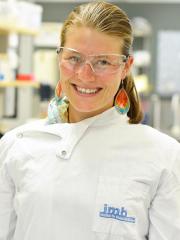Ms Lin Grimm
Higher degree by research (PhD) student
Institute for Molecular Bioscience

Journal Articles
Grimm, Lin, Mason, Elizabeth, Yu, Hujun, Dudczig, Stefanie, Panara, Virginia, Chen, Tyrone, Bower, Neil I., Paterson, Scott, Rondon Galeano, Maria, Kobayashi, Sakurako, Senabouth, Anne, Lagendijk, Anne K., Powell, Joseph, Smith, Kelly A., Okuda, Kazuhide S., Koltowska, Katarzyna and Hogan, Benjamin M. (2023). Single‐cell analysis of lymphatic endothelial cell fate specification and differentiation during zebrafish development. The EMBO Journal, 42 (11) e112590, e112590. doi: 10.15252/embj.2022112590
Britto, Denver D., He, Jia, Misa, June P., Chen, Wenxuan, Kakadia, Purvi M., Grimm, Lin, Herbert, Caitlin D., Crosier, Kathryn E., Crosier, Philip S., Bohlander, Stefan K., Hogan, Benjamin M., Hall, Christopher J., Torres-Vázquez, Jesús and Astin, Jonathan W. (2022). Plexin D1 negatively regulates zebrafish lymphatic development. Development, 149 (21) dev200560. doi: 10.1242/dev.200560
Grimm, Lin and Hogan, Benjamin M. (2021). Network patterning, morphogenesis and growth in lymphatic vascular development. Current Topics in Developmental Biology, 143, 151-204. doi: 10.1016/bs.ctdb.2020.10.007
Grimm, Lin, Nakajima, Hiroyuki, Chaudhury, Smrita, Bower, Neil I., Okuda, Kazuhide S., Cox, Andrew G., Harvey, Natasha L., Koltowska, Katarzyna, Mochizuki, Naoki and Hogan, Benjamin M. (2019). Yap1 promotes sprouting and proliferation of lymphatic progenitors downstream of Vegfc in the zebrafish trunk. eLife, 8 e42881. doi: 10.7554/elife.42881
Agarwala, Sobhika, Duquesne, Sandra, Liu, Kun, Boehm, Anton, Grimm, Lin, Link, Sandra, König, Sabine, Eimer, Stefan, Ronneberger, Olaf and Lecaudey, Virginie (2015). Amotl2a interacts with the hippo effector yap1 and the Wnt/β-catenin effector lef1 to control tissue size in zebrafish. eLife, 4 (September 2015) e08201. doi: 10.7554/eLife.08201
Thesis
Grimm, Lin (2020). Characterisation of key transcription factors governing lymphatic vascular development. PhD Thesis, Institute for Molecular Bioscience, The University of Queensland. doi: 10.14264/uql.2020.484
